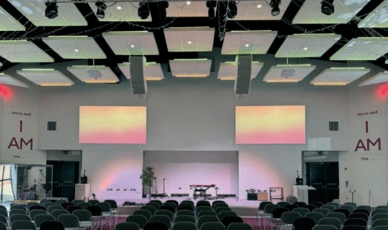Which screen solution is best for you?
Rob Alvis of Creative Audio-Visual Solutions (CAVS) looks at the latest developments
In the past there have been numerous articles where comparisons have been made between projection and TV-style displays. Now that there has been a number of notable technology developments within all sectors, it seems a good time to revisit the subject.
When a church is looking at an audio-visual system, the discussion between what type of display or screen is probably the first item on the agenda. So let’s look at each technology in regard to what the latest developments have been and the all-important pros and cons:

Projection
Most churches have used some sort of projector in the past, so this is not a new technology: although recent advancements are worth highlighting. Previously, projectors used lamps as their light source – those are prone to brightness degradation from the moment you turn the projector on and within a year there will likely be a noticeable drop-off in performance.
Bearing in mind a lamp should be changed every 3-5 years, depending on usage and ambient conditions, such as temperature and humidity, that type of projector only really gives out its best for a third or less of its life. Much like within the vehicle industry, the big change is the main ‘engine’ – or in this case the light source within projection.
Lamps have now been replaced with laser technology, which will run for the life of the projector – so no issues regarding lamp failures just before or mid-service! Yes, there is brightness degradation, but this is so slow it is almost unnoticeable during the lifespan of a church-based projector.
Where projectors have a bad name is the under-specifying of a system based on screen size and ambient light levels. With falling costs it is far easier to get the right projector, with the correct brightness levels, for a particular situation; and therefore they should now be more comparable with ‘TV’ quality in terms of image quality.
With all things equal, pros as they stand will be: good viewing angle, ability to hide a screen away or project onto a bare wall and the ability for larger screen sizes – typically above 2m wide. The cons would be increased maintenance (filters), negative effect from high ambient light or direct sunlight, fan noise if the projector is in a position close to the congregation and brightness/image quality if the correct projector cannot be afforded.
 IPS/LED displays
IPS/LED displays
For most, these are ‘TVs’: fixed screens of certain sizes. The two main technologies are LED and IPS. Without going into detail, there are benefits with both; but for church applications they are less relevant. Commercial displays are recommended, both in terms of performance, reliability and warranty, and with new anti-glare displays available they do provide exceptional image quality and performance in high ambient light conditions. Domestic TVs are very much a budgetary consideration and due to glass or high-gloss panels, they provide poor performance with light reflection/viewing angles.
The main downside with fixed displays is that there is no hiding a big black panel when not in use. Yes, you can use screensavers and backgrounds; but you can’t hide them away or disguise them easily. Within the more modern church that is less of an issue and in more traditional churches they are popular as repeater or ‘behind pillar’ displays where perhaps the main projection screen is obscured.
In most situations they do provide the best image quality – certainly when it comes to price – but there needs to be a consideration in terms of mounting. Screen sizes are generally available from 19” to 98”. Displays at the larger end can weight close to 100kgs each, so that needs to be considered in terms of placement and accessibility.
 LED video walls
LED video walls
Due to cost, these have only recently become an option for some churches. They are the type of displays you will often see at sports stadiums, advertising hoardings and shopping centres and the like. They consist of a number of smaller ‘tiles’ which together can create a virtually limitless size of screen.
Like TV-style displays, they cannot be hidden and will require even more involved mounting hardware and fixing consideration; but for the most striking images, due to high brightness LEDs, they cannot be beaten. If you want a very large seamless display or backdrop with no shadowing or negative effects from ambient light, a video wall is the only real option. Returning to cost, which will generally start or end the conversation, you will generally be looking at £25,000 upwards for a 3m display with high-definition resolution. For a large backdrop you can quite easily move into six figure costs.
Here at Creative Audio-Visual Solutions, we have vast knowledge and experience in all those technologies. A discussion at your building will quickly ascertain the right solution: indeed there may be options for more than one which may then come down to cost and/or aesthetics.
For a free on-site consultation, or to begin the conversation, get in touch. ‘Like’ us on Facebook (Cavsolutions) for the latest installation case studies and product news, or tel 01707 518400; email This email address is being protected from spambots. You need JavaScript enabled to view it.; or visit www.cavsolutions.co.uk.













